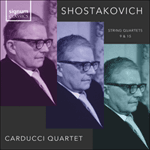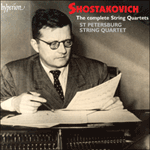
Welcome to Hyperion Records, an independent British classical label devoted to presenting high-quality recordings of music of all styles and from all periods from the twelfth century to the twenty-first.
Hyperion offers both CDs, and downloads in a number of formats. The site is also available in several languages.
Please use the dropdown buttons to set your preferred options, or use the checkbox to accept the defaults.

| Carducci String Quartet» More |
Shostakovich’s contribution to the string quartet repertoire is one of the most important of any twentieth-century composer—not purely in the number of his works but in the range and undeviating quality of them. Shostakovich’s Fifteenth Quartet is one of the most moving of all his compositions, the most intimate, and of his chamber works the most directly concerned—in so far as such a claim can be made—with death. The profound melancholy of this music is akin to a Requiem—but not necessarily for himself, although when the work was written Shostakovich must have known his time on earth was now limited.
The final quartet comprises six linked Adagio movements: Elegy, Serenade, Intermezzo, Nocturne, Funeral March and Epilogue, and was completed on 17 May 1974; the first performance took place the following October, by the Taneyev String Quartet, in Leningrad. The first performance in Moscow was by the Beethoven Quartet, on 11 January 1975.
The first movement is a sombre and stately meditation on two simple ideas, unhurried and peaceful, which anchor the music irreducibly to E flat minor and which recall chants from the Kontakion. The Serenade opens with twelve searing cries, which recur at intervals in the movement, juxtaposed with equally dramatic outbursts of pizzicato chords and a recitative-like line, before an angular little waltz passes by. Over a deep pedal, the extraordinary Intermezzo now appears: a powerfully dramatic solo violin cadenza erupts, interspersed with tutti references to scraps from the Serenade, before the Nocturne emerges. This is a relatively impressionistic movement, characterised by delicate tracery from second violin and cello through which the viola initially weaves an expressive line. This becomes the basis for much of the movement’s development before a simple march rhythm pushes itself forward, taken up by the entire quartet to begin the Funeral March proper, punctuated with solo lines from the viola, cello and first violin.
This material is also varied, but gradually the passion ebbs from it, and the quietly flickering Epilogue ensues, with fluttering lines oscillating within the texture, interspersed with reminiscences from earlier parts of the work. The fluttering lines gather themselves for a final outburst, and then—very gradually, over a long paragraph—the music, drained of almost all of its fragile energy, at last withdraws into a reposeful acceptance of Fate.
from notes by Robert Matthew-Walker © 2002
La contribution de Chostakovitch au répertoire du quatuor à cordes est l’une des plus importantes du XXe siècle, non seulement de par le nombre des compositions mais aussi de par la variété et la qualité constante des œuvres. Le Quinzième quatuor à codes de Chostakovitch est l’une de ses œuvres les plus émouvantes, les plus intimes. De toutes ses pièces pour orchestre de chambre, c’est certainement celle qui se préoccupe le plus directement de la mort. La profonde mélancolie qui se dégage de cette musique évoque celle d’un Requiem, non pour le compositeur lui-même mais dans l’absolu, bien que lorsqu’il écrivit ce quatuor, Chostakovitch sût que son heure était bientôt venue.
Ce quatuor final comprend six mouvements Adagio liés les uns aux autres: Élégie, Sérénade, Intermezzo, Nocturne, Marche funèbre et Épilogue, et sera terminé le 17 mai 1974; la première performance a lieu au mois d’octobre suivant et met en scène le Quatuor Taneyev à Leningrad. La première performance à Moscou est assurée par le Quatuor Beethoven, le 11 janvier 1975.
Le premier mouvement est une méditation sombre et imposante sur deux idées simples, lentes et paisibles, qui ancre profondément la musique dans la tonalité de mi bémol mineur et qui évoque les chants du Kontakion. La Sérénade s’ouvre sur douze cris poignants, réitérés à différents endroits du mouvement, juxtaposés à des sursauts tout aussi dramatiques d’accords pizzicato et à une ligne de style récitatif, avant le passage d’une petite valse angulaire et pointue. Sur des accents profonds intervient alors l’extraordinaire Intermezzo: une puissante cadence au violon seul se fait entendre, parsemée de références à la Sérénade, jouées par l’ensemble, avant de laisser la place au Nocturne. Voilà un mouvement relativement impressionniste, caractérisé par les évocations délicates au second violon et au violoncelle, qui s’entremêlent pour former une ligne expressive marquante. Ceci devient la fondation du développement du mouvement avant qu’une simple marche ne s’impose pour donner la Marche funèbre ponctuée de traits à l’alto, au violoncelle et au premier violon.
Le développement est aussi varié, mais la passion s’en échappe progressivement, et l’Épilogue à la texture éphémère apparaît telle une étincelle fragile qui luit de brèves réminiscences des parties précédentes de l’œuvre. Les traits palpitants s’unissent en un dernier sursaut et lentement, le temps d’un long paragraphe, la musique vidée de son énergie fragile se retire avec grâce, en acceptant avec sérénité le Destin.
extrait des notes rédigées par Robert Matthew-Walker © 2002
Français: Marie Luccheta
Wie wir anlässlich der Besprechung der früheren Werke dieser Serie festgestellt haben, zählt Schostakowitschs Beitrag zum Repertoire für Streichquartett zu den bedeutendsten, die ein Komponist des zwanzigsten Jahrhunderts geleistet hat—und zwar nicht allein durch die Zahl seiner Werke, sondern auch durch ihre Bandbreite und durchweg hohe Qualität. Schostakowitschs Fünfzehntes Quartett ist eine seiner ergreifendsten und intimsten Kompositionen und dasjenige Streichquartett, das—soweit man so eine Behauptung überhaupt aufstellen darf—am stärksten mit dem Tod befasst ist. Die profunde Melancholie des Werks hat etwas von einem Requiem—aber nicht unbedingt für die eigene Person, obwohl Schostakowitsch, als er es komponiert hat, sicher wusste, dass seine Zeit auf Erden begrenzt war.
Das letzte Quartett setzt sich aus sechs miteinander verbundenen Adagiosätzen zusammen: Elegie, Serenade, Intermezzo, Nocturne, Trauermarsch und Epilog. Es wurde am 17. Mai 1974 fertig gestellt, und die Uraufführung in Leningrad besorgte im Oktober des Jahres das Tanejew-Quartett. Die erste Moskauer Aufführung spielte das Beethoven-Quartett am 11. Januar 1975.
Der erste Satz ist eine ernste und feierliche Meditation über zwei schlichte, gemächlich und friedlich gestimmte Ideen, die die Musik unwiderruflich in es-Moll verankern und an Gesänge aus dem Kontakion erinnern. Die Serenade beginnt mit zwölf eindringlichen Schreien, die sich in Abständen im Verlauf des Satzes wiederholen; ebenso dramatische Ausbrüche von Pizzicato-Akkorden und eine rezitativische Melodielinie werden ihnen gegenübergestellt, und dann zieht ein kantiger kleiner Walzer vorbei. Über einem tiefen Orgelpunkt erklingt nun das außergewöhnliche Intermezzo: eine eindrucksvoll dramatische Soloviolinkadenz bricht hervor, solange durchsetzt mit Tutti-Verweisen auf Bruchstücke aus der Serenade, bis die Nocturne hervortritt. Es handelt sich um einen eher impressionistischen Satz, gekennzeichnet durch fein ziselierte Klänge auf der Zweiten Geige und dem Cello, durch die die Bratsche zu Anfang eine expressive Melodielinie fädelt. Diese Linie dient als Grundlage für große Teile der Durchführung des Satzes; dann schiebt sich ein einfacher Marschrhythmus in den Vordergrund, der vom gesamten Quartett aufgegriffen wird und den eigentlichen Trauermarsch einleitet, unterbrochen durch Solopassagen der Bratsche, des Cellos und der Ersten Geige.
Dieses Material ist genauso abwechslungsreich, doch die Leidenschaft darin lässt immer mehr nach, und der leise flackernde Epilog entspinnt sich mit flatternden Linien, die innerhalb der Textur oszillieren, und eingestreuten Reminiszenzen an zuvor gehörte Abschnitte des Werks. Die flatternden Linien versammeln sich zu einem letzten Ausbruch, und dann zieht sich die Musik—ganz allmählich über eine lange Passage hin—in ruhige Duldung des Schicksals zurück.
aus dem Begleittext von Robert Matthew-Walker © 2002
Deutsch: Anne Steeb/Bernd Müller
 Shostakovich: String Quartets Nos 9 & 15 Shostakovich: String Quartets Nos 9 & 15Shostakovich's String Quartet No 9—composed in 1960 and playing in five continuous movements of which the fifth is by some margin the most weighty—is here coupled with the composer's final contribution to the genre. No 15 is imbued with a profound ...» More |
 Shostakovich: The Complete String Quartets Shostakovich: The Complete String Quartets‘These players approach Shostakovich's mighty cycle with a natural authority that's unanswerable, along with tireless precision and virtuosity, plus a ... ‘The St Petersburg musicians play with tremendous control of technique and expression; the effect is one of huge emotional strength’ (Birmingham Post)» More |

